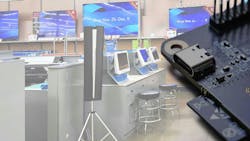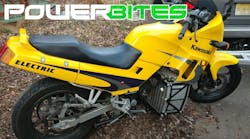USB-C Charger Design First to Deliver 240 W from Single 1C Port
According to Pulsiv Limited, it’s the first company to offer a solution that delivers 240 W from a single USB-C port. The charger design combines a Pulsiv OSMIUM front-end design with an industry-standard flyback architecture that passes strict EMC/Line Current requirements.
Until now, existing 240-W USB-C charger designs got around the technology’s de facto 140-W maximum limit for a single port by distributing the power across multiple ports. This made using USB-C difficult for many higher power applications such as monitors, gaming laptops, and small domestic appliances. In addition, those earlier Boost PFC+LLC-based designs made EMC compliance challenging, due to their inherently high noise emissions.
Pulsiv solved these problems by using its OSMIUM technology to support a quieter, more efficient flyback architecture that can be used at higher power levels. In addition to reducing the recharge time of portable electronics by up to 80%, it can benefit line-powered applications.
Nick Theodoris, Pulsiv’s Director of Global Sales, said, “Applications such as televisions, monitors, projectors, and games consoles can also benefit from 240-W USB-C power supplies by enabling the power electronics to be removed from the product, significantly reducing their overall size, weight, and cost.”
The company plans to offer three options for deploying the technology:
- Reference design: A reference design containing a datasheet, schematic, and bill of materials will be published on www.pulsiv.com in the coming weeks.
- Standard assembled module: For those whose resources and time are limited, Pulsiv will offer a standard, fully assembled module with 1x USB-C connector. Pre-orders for samples can be placed now for delivery in late March 2025, with mass-production quantities being delivered from July 2025 onward.
- Custom assembled module: For anyone who has more specific requirements, custom assembled modules will also be offered. This flexible option will come with an NRE of just $10,000 and an MOQ of 500 pieces.
Next in This Issue of PowerBites
More PowerBites
About the Author
Lee Goldberg
Contributing Editor
Lee Goldberg is a self-identified “Recovering Engineer,” Maker/Hacker, Green-Tech Maven, Aviator, Gadfly, and Geek Dad. He spent the first 18 years of his career helping design microprocessors, embedded systems, renewable energy applications, and the occasional interplanetary spacecraft. After trading his ‘scope and soldering iron for a keyboard and a second career as a tech journalist, he’s spent the next two decades at several print and online engineering publications.
Lee’s current focus is power electronics, especially the technologies involved with energy efficiency, energy management, and renewable energy. This dovetails with his coverage of sustainable technologies and various environmental and social issues within the engineering community that he began in 1996. Lee also covers 3D printers, open-source hardware, and other Maker/Hacker technologies.
Lee holds a BSEE in Electrical Engineering from Thomas Edison College, and participated in a colloquium on technology, society, and the environment at Goddard College’s Institute for Social Ecology. His book, “Green Electronics/Green Bottom Line - A Commonsense Guide To Environmentally Responsible Engineering and Management,” was published by Newnes Press.
Lee, his wife Catherine, and his daughter Anwyn currently reside in the outskirts of Princeton N.J., where they masquerade as a typical suburban family.
Lee also writes the regular PowerBites series.





